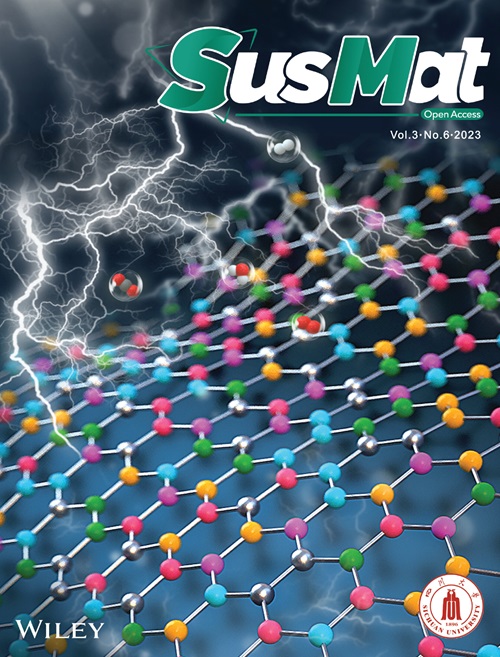A real proton‐conductive, robust, and cobalt‐free cathode for proton‐conducting solid oxide fuel cells with exceptional performance
IF 18.7
1区 材料科学
Q1 CHEMISTRY, MULTIDISCIPLINARY
引用次数: 5
Abstract
Abstract The development of proton, oxygen‐ion, and electron mixed conducting materials, known as triple‐conduction materials, as cathodes for proton‐conducting solid oxide fuel cells (H‐SOFCs) is highly desired because they can increase fuel cell performance by extending the reaction active area. Although oxygen‐ion and electron conductions can be measured directly, proton conduction in these oxides is usually estimated indirectly. Because of the instability of cathode materials in a reducing environment, direct measurement of proton conduction in cathode oxide is difficult. The La 0.8 Sr 0.2 Sc 0.5 Fe 0.5 O 3– δ (LSSF) cathode material is proposed for H‐SOFCs in this study, which can survive in an H 2 ‐containing atmosphere, allowing measurement of proton conduction in LSSF by hydrogen permeation technology. Furthermore, LSSF is discovered to be a unique proton and electron mixed‐conductive material with limited oxygen diffusion capability that is specifically designed for H‐SOFCs. The LSSF is an appealing cathode choice for H‐SOFCs due to its outstanding CO 2 tolerance and matched thermal expansion coefficient, producing a record‐high performance of 2032 mW cm −2 at 700°C and good long‐term stability under operational conditions. The current study reveals that a new type of proton–electron mixed conducting cathode can provide promising performance for H‐SOFCs, opening the way for developing high‐performance cathodes.一个真正的质子导电,坚固,无钴阴极的质子导电固体氧化物燃料电池具有卓越的性能
质子、氧离子和电子混合导电材料的开发,被称为三重导电材料,作为质子导电固体氧化物燃料电池(H - SOFCs)的阴极是非常需要的,因为它们可以通过扩大反应活性区域来提高燃料电池的性能。虽然氧离子和电子的电导率可以直接测量,但这些氧化物中的质子电导率通常是间接估计的。由于阴极材料在还原环境中的不稳定性,直接测量阴极氧化物中的质子传导是困难的。本研究提出了La 0.8 Sr 0.2 Sc 0.5 Fe 0.5 O 3 - δ (LSSF)阴极材料,该材料可以在含h2的大气中存活,可以通过氢渗透技术测量LSSF中的质子传导。此外,LSSF被发现是一种独特的质子和电子混合导电材料,具有有限的氧扩散能力,是专门为氢sofc设计的。LSSF是氢sofc极具吸引力的阴极选择,因为它具有出色的CO 2容忍度和匹配的热膨胀系数,在700°C下可产生创纪录的2032 mW cm - 2的高性能,并且在运行条件下具有良好的长期稳定性。目前的研究表明,一种新型的质子-电子混合导电阴极可以为氢SOFCs提供良好的性能,为开发高性能阴极开辟了道路。
本文章由计算机程序翻译,如有差异,请以英文原文为准。
求助全文
约1分钟内获得全文
求助全文
来源期刊
自引率
4.20%
发文量
0
期刊介绍:
SusMat aims to publish interdisciplinary and balanced research on sustainable development in various areas including materials science, engineering, chemistry, physics, and ecology. The journal focuses on sustainable materials and their impact on energy and the environment. The topics covered include environment-friendly materials, green catalysis, clean energy, and waste treatment and management. The readership includes materials scientists, engineers, chemists, physicists, energy and environment researchers, and policy makers. The journal is indexed in CAS, Current Contents, DOAJ, Science Citation Index Expanded, and Web of Science. The journal highly values innovative multidisciplinary research with wide impact.

 求助内容:
求助内容: 应助结果提醒方式:
应助结果提醒方式:


